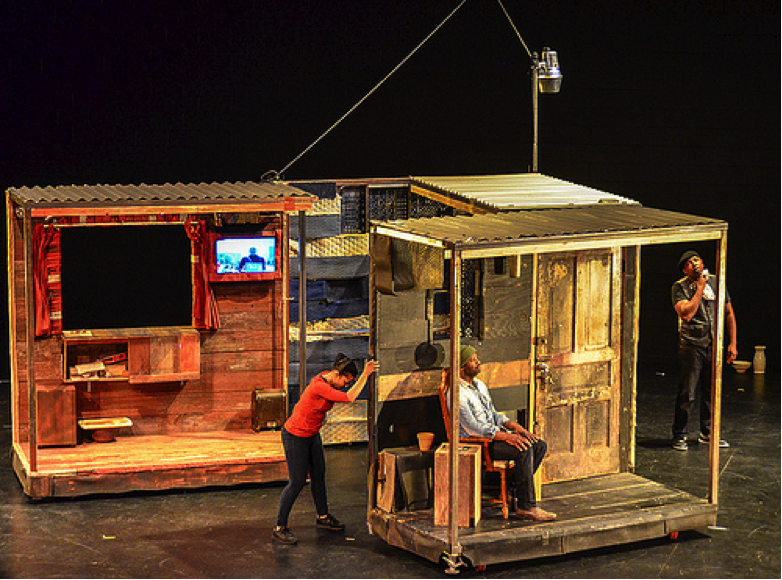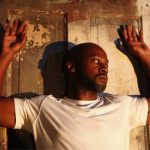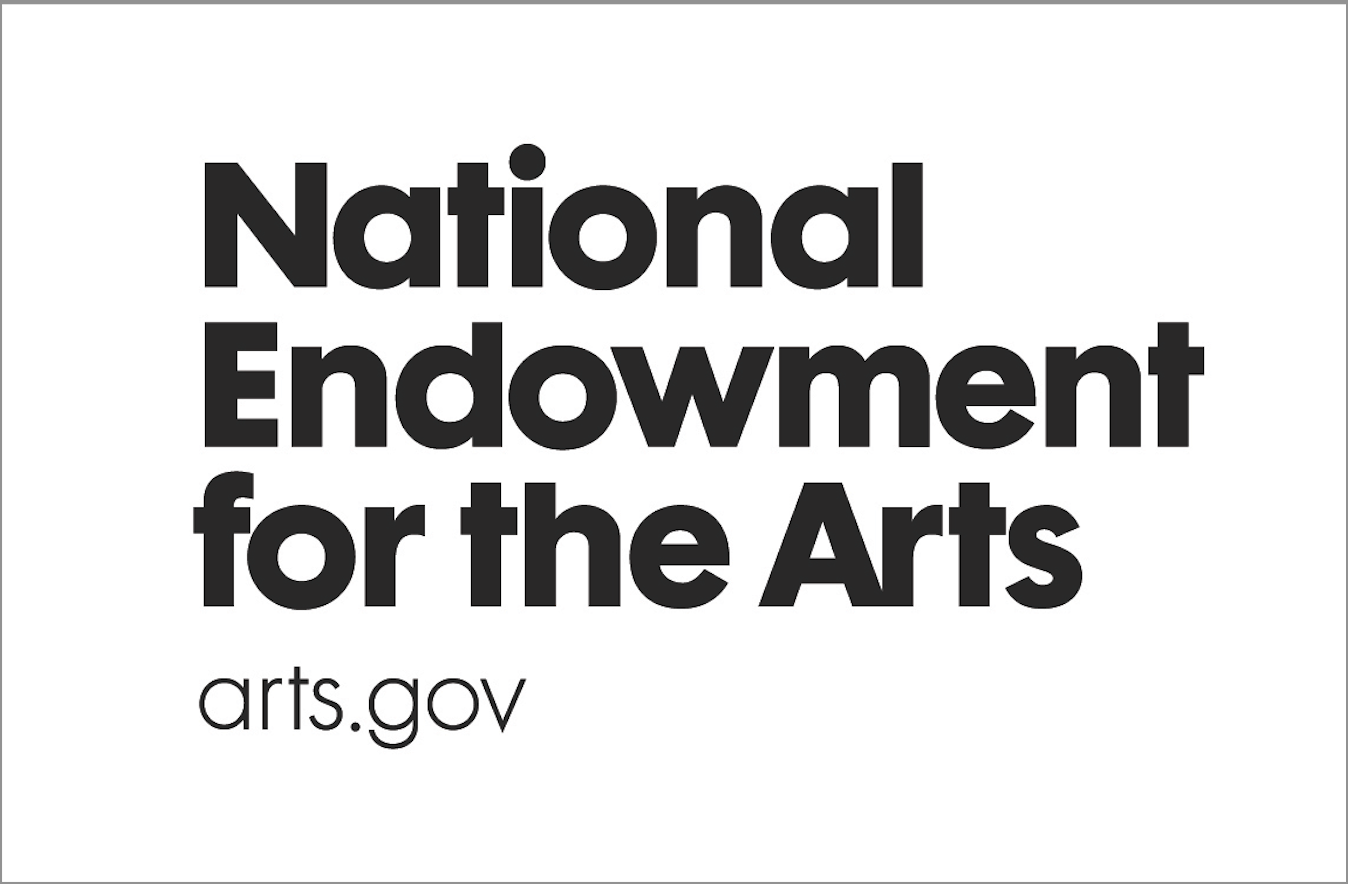Marc Bamuthi Joseph wears many hats: spoken-word poet, playwright, director, dancer, educator, activist, environmentalist and artistic director of the Living Word Project. His interactive visual arts exhibition and performed documentary “red, black & GREEN: a blues” toured to venues across America from 2011 to 2014. Amina Henry spoke to Marc about about color, elements, space, and how he uses performance to create intentional communities.
AMINA HENRY: How did “red, black and GREEN: a blues” get started?
MARC BAMUTHI JOSEPH: The genesis started probably in 2007. Robert Redford, through Sundance, gave my non-profit organization some money to encourage young poets to create work at the intersection of their physical environment, their social environment, and the global environment. And the program is called “Brave New Voices Speak Green.” We started a program with high visibility that enabled young people that created exemplary work to perform all over the world. So they were in Australia, they were in Europe, they were all over the country. But wherever we went, kind of doing these poems, there were never people of color there. So at the start of 2008, I endeavored to be more demographically specific and charged in terms of figuring out ways this work that was being largely performed by people of color could connect in a more specific way to black and brown folk in under-resourced neighborhoods. So we created a second program called “Life is Living” in October of 2008.
Mos Def was the headliner at this festival, and we did our very best to connect with local green agencies in order to expand vocabulary in and around the green movement, green issues. The festival was really successful, people were really there, you know, lots of people came, but we didn’t create anything systemic in terms of partnership, in terms of relationship, in terms of follow through. So what we pitched to Doris Duke was to continue the pathway of extending environmental literacy in black and brown neighborhoods, but to focus more on the relationship building before and after. And we landed this process in partnership with different institutions around the country. We worked with the Museum of Contemporary Art in Chicago, we worked with the Hip Hop Theater Festival at Riverside Church in New York and we worked with the Cynthia Woods Mitchell Center and Project Willhouses in Houston. And Walker Arts Center and Juxtaposition Arts in Minneapolis. And we developed a process that we called ‘creative ecosystems’ that served as the kind of pedagogical foundation for how “Life Is Living” happens throughout the country.
“Every city corresponds to a color, corresponds to an element, corresponds to a musical style.”
So “red, black and GREEN: a blues” is a performed documentary of that process. It illuminates some of the narrative, some of the people, some of the tension, and some of the discovery that was made while producing Life Is Living in Houston, Harlem, Chicago, and Oakland.
AMINA: How was the work built? Was it a matter of interviewing a bunch of people and then piecing their narratives together?
MARC: I think less that. I mean, I, like many writers, work in close observation, but I’m not a journalist. I don’t work, let’s say, like the Civilians do. I get inside of communities maybe in a different kind of way. The text and the dramaturgy comes more out of a place of observation than notation or dictation.
Part of what we also decided in terms of building the piece was to have an elemental and musical score that related to the various cities that we were in. New York feels like hip hop to me. Oakland is like a funk and soul score that is also of water. Chicago is really more out of a jazz and gospel tradition and has a corresponding element of fire. Houston moves out of the blues tradition, and the element that we assigned it was black, or we assigned it oil and the color was black. So every city corresponds to a color, corresponds to an element, corresponds to a musical style. So Chicago, fire, black. Houston, oil, green. New York, land, blue. Oakland, earth. So that’s it, right? There are element signatures, musical signatures and general reliance on the poet to serve as a prism and funnel for these disparate experiences.
AMINA: Did you go away and create a sort of template script that you and the performers tweaked during the rehearsal process? Or did you come in with a finished script?
MARC: We came in with a script that I wrote. Everyone kind of contributed something. Theaster Gates did the concept for the set and then designed and built it with his team. Tommy Shephard was really experimenting with what’s possible for using that set to make music. I remember he came in on the first day and he had all this gear and our director Michael Garcés was like, “Nothing electronic. You have to use the set to make music.” So we got him old dominoes. We hung bells on the set. What he does is extraordinary, the way that he turns physical objects into resonant instruments is pretty extraordinary. And, likewise, the no-new-materials that we used in making the set — the entire set is made of found materials, which is also Theaster’s way. You know, at the time he was doing these “Requiem for Civil Rights” pieces, where he used all these decommissioned fire hoses that the fire department — one fire department in Chicago and I think another one in Alabama had decommissioned these fire hoses, and he took them apart, gutted them, and used them as borders for some of the set elements. It’s interesting, because it’s just part of a series that he’s doing. And some of his more celebrated work — these epigraphs for Civil Rights — they show up in different museum pieces across the country. So everyone really was responsible for bringing their thing, from Bethany Hines’s photography to David Szlasa’s media design. My writing, I think, was a foundation for the inquiry, but the collaboration really took hold from there.

“red, black & GREEN: a blues.” Photo Credit: Bethany Hines Photography.
AMINA: I really loved the town hall meeting feeling, for lack of a better way of putting it. It was a very communal gathering, different than regular theater tends to be. Like we’re all gonna stand around a campfire, in a sense, and just tell stories to each other.
MARC: Yeah. Some of that really comes out of a designed implication, this sense of an instant community. We talk about intentional community design, which is really what “Life Is Living” has become, not so much in terms of who shows up, but in terms of how it gets put together. Reflecting that experience onstage for us meant creating this kind of prologue where the audience is onstage with us. And the manipulation of the set pieces choreographed the audience in a certain kind of way that I think ultimately leads to this implication, which then resonates throughout the piece as it continues to evolve and transform both the people that are watching it and the people that are making it happen. I think that’s a great metaphor for what we are trying to accomplish in general, in terms of thinking about environment. It is an other; it’s not something to be witnessed, it’s something that we all participate in. When we talk about sustainability, I think part of the focus of the show is that what’s most sustainable — what must be first sustainable — is the relationship that we have to one another. And the more we position each other, or positions ourselves, in these kind of moments of witness, or these postures of witness, as opposed to cooperation or collaboration, like, that’s really where we want to be if we want to be successful in making the environmental enterprise something in which we all are stakeholders.
AMINA: Yeah, it’s a big job, dealing with the environment. But it definitely feels like you provide a kind of pathway towards hope. I find that when I think about the environment, in addition to things like hunger, it becomes so overwhelming.
MARC: Totally. That’s the other thing, you’re absolutely right. Part of the thing of having audience or community onstage with us is this thing of coming close. It’s a refrain you hear throughout the piece: “If you look real close, you can see he has twenty-seven hairs on his chin.” “I bet you can find… if you look real close.” “If you look real close, the inside of his eyes.” That language comes up again and again, because you have to be close to it, because the further back away you get, the more intimidating the whole thing gets. You know? Like when you look at it on a cosmological level, it’s like, “Aw, man, what the fuck am I gonna do? In my lifetime? Like how does this two minute shower as opposed to a ten minute shower really make a dent?” You know?
AMINA: But we have faith that it does.
MARC: Exactly. Exactly. Exactly. And you know, faith is hard.
 Marc Bamuthi Joseph has developed several poetry-based works for the stage — among them: “Word Becomes Flesh,” “Scourge” and “break/s” — that have toured across the US, Europe, and Africa. An acclaimed educator and essayist, Joseph has lectured at more than 200 colleges and universities, appeared as a commentator on NPR and carried adjunct professorships at Stanford University, Lehigh University, Mills College and the University of Wisconsin. He is the co-founder of Life is Living, a national series of one-day festivals designed to activate under-resourced parks and affirm peaceful urban life through hip-hop arts and focused environmental action. Joseph is also the artistic director of the seven-part HBO documentary “Russell Simmons Presents Brave New Voices” and an inaugural recipient of the United States Artists Rockefeller Fellowship. He is the 2011 Alpert Award winner in theater, and, in April 2012, he was one of 21 artists named to the inaugural class of Doris Duke Artists. He currently serves as director of performing arts at Yerba Buena Center in San Francisco.
Marc Bamuthi Joseph has developed several poetry-based works for the stage — among them: “Word Becomes Flesh,” “Scourge” and “break/s” — that have toured across the US, Europe, and Africa. An acclaimed educator and essayist, Joseph has lectured at more than 200 colleges and universities, appeared as a commentator on NPR and carried adjunct professorships at Stanford University, Lehigh University, Mills College and the University of Wisconsin. He is the co-founder of Life is Living, a national series of one-day festivals designed to activate under-resourced parks and affirm peaceful urban life through hip-hop arts and focused environmental action. Joseph is also the artistic director of the seven-part HBO documentary “Russell Simmons Presents Brave New Voices” and an inaugural recipient of the United States Artists Rockefeller Fellowship. He is the 2011 Alpert Award winner in theater, and, in April 2012, he was one of 21 artists named to the inaugural class of Doris Duke Artists. He currently serves as director of performing arts at Yerba Buena Center in San Francisco.
Post Views:
924

 Marc Bamuthi Joseph has developed several poetry-based works for the stage — among them: “Word Becomes Flesh,” “Scourge” and “break/s” — that have toured across the US, Europe, and Africa. An acclaimed educator and essayist, Joseph has lectured at more than 200 colleges and universities, appeared as a commentator on NPR and carried adjunct professorships at Stanford University, Lehigh University, Mills College and the University of Wisconsin. He is the co-founder of Life is Living, a national series of one-day festivals designed to activate under-resourced parks and affirm peaceful urban life through hip-hop arts and focused environmental action. Joseph is also the artistic director of the seven-part HBO documentary “Russell Simmons Presents Brave New Voices” and an inaugural recipient of the United States Artists Rockefeller Fellowship. He is the 2011 Alpert Award winner in theater, and, in April 2012, he was one of 21 artists named to the inaugural class of Doris Duke Artists. He currently serves as director of performing arts at Yerba Buena Center in San Francisco.
Marc Bamuthi Joseph has developed several poetry-based works for the stage — among them: “Word Becomes Flesh,” “Scourge” and “break/s” — that have toured across the US, Europe, and Africa. An acclaimed educator and essayist, Joseph has lectured at more than 200 colleges and universities, appeared as a commentator on NPR and carried adjunct professorships at Stanford University, Lehigh University, Mills College and the University of Wisconsin. He is the co-founder of Life is Living, a national series of one-day festivals designed to activate under-resourced parks and affirm peaceful urban life through hip-hop arts and focused environmental action. Joseph is also the artistic director of the seven-part HBO documentary “Russell Simmons Presents Brave New Voices” and an inaugural recipient of the United States Artists Rockefeller Fellowship. He is the 2011 Alpert Award winner in theater, and, in April 2012, he was one of 21 artists named to the inaugural class of Doris Duke Artists. He currently serves as director of performing arts at Yerba Buena Center in San Francisco.
